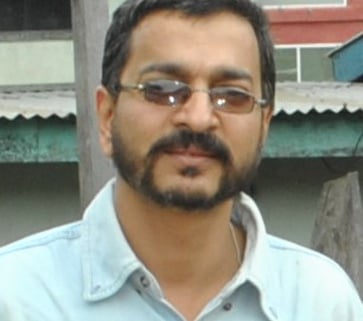OBSERVATIONS ON MANIPUR UNREST
OPINION & ANALYSIS


Rajeev Bhattacharyya
Senior journalist
Guwahati: As a journalist from Guwahati who has covered the Northeast for over two decades, I feel tempted to pen my observations on the ongoing unrest in Manipur which should not be misconstrued as expert comments. I have visited the state at regular intervals either for reporting or for seminars that took me to remote regions including the border zones and the hill districts. Understanding the state is a more difficult task in a brief span than either Mizoram, Nagaland or any of the states in the Northeast.
My last visit to Manipur was between March 21 – 30 with the objective to gather information on the Myanmarese resistance groups active along the state’s border with the neighbouring country and interviewing some leaders. I stationed myself at Moreh which enabled me to travel to some areas along both sides of the border in Tengnoupal.
Besides interacting with functionaries of the resistance groups, I had the opportunity to speak to a cross-section of people belonging to the Kuki, Meitei, Tamil and Hindi-speaking communities at Moreh and the surrounding areas. The Meitei and the Kuki were reluctant to share information but some hints were dropped by members of the other two groups about the existing situation in the border town.
UNDERCURRENTS OF TENSION
The unwillingness to discuss was an indication that not everything at Moreh was alright. But business was on as usual with the hordes of vendors from Myanmar pouring in to sell their stuff everyday through the narrow gaps along the border. But something was certainly amiss which I could not discern easily.
“They (vendors) are a worried lot like the traders who do business with people in Moreh,” said the manager of the lodge where we had checked in. “Tamu is reeling under heavy fighting between the military and resistance forces. The business could come to a halt any day.”
This was no surprise given the ongoing war in Myanmar and especially in Sagaing Region which borders Manipur. What came as a bit of astonishment was the tension that seemed to be brewing between the different communities in the town. A Tamil who owns an eatery was of the view that the situation had undergone a gradual change over the past decade or so. Perhaps the evidence lay in the relocation of some Tamil families to Tamil Nadu in the recent past. I spoke to one of them on the phone who confirmed that Moreh was no longer what it used to be a decade ago.
Still, I surmised that there was no reason to be concerned. There had been many inter-ethnic clashes in Manipur but none among the Meitei and the Chin-Kuki-Zo earlier. And it was here that our assessment had fumbled like many people elsewhere in the state and the country. Nobody could envisage that the conflict would drag for so long, nor the huge casualties and the scale of displacement and the rare incidents that unfolded which were never witnessed earlier in the Northeast.
Extraordinary Episodes
The list of extraordinary episodes in the last four months in Manipur is long. To begin with, nowhere in independent India have so many weapons been looted by irate mobs from police armouries. Nowhere have drones been used by the warring groups, or bunkers constructed as a safeguard against attacks. Neither were rocket launchers or bullet-proof vests manufactured locally – a trend discernible at many places in Myanmar which I had noticed during my sojourns between January – March in Chin State and Sagaing Region.
Foreign governments and organizations have reacted on many occasions to episodes in India. After the Gujarat riots of 2002, Prime Minister Narendra Modi was denied a visa by the US government. But an ‘urgency resolution’ by the European Parliament on Manipur which made a case for ‘urgent steps’ to defuse the crisis and ‘regular dialogue’ between the two Parliaments and the statement from US ambassador Eric Garcetti offering assistance to resolve the conflict in the state were extremely ‘rare episodes’ according to a section of government officials.
Likewise, the animosity between the Manipur Police and Assam Rifles or the incident of 25 June in Imphal when the army was compelled to release 12 rebels of KYKL after being surrounded by a mob led by women were unheard of incidents in the country which reveal a lot about the situation in Manipur.
FAILURE OF STATE & SOCIETY
Whatever the nature and intensity of the violence, they point to the failure of the state and society to anticipate the unrest which was bound to manifest sooner or later. In this case, the failure in Manipur is somewhat akin to Assam’s where the indigenous communities in Brahmaputra Valley failed to gauge the danger from illegal Bangladesh immigrants and the need for a stringent regime of preventive measures years ago. In Manipur, the skewed laws of land holding were bound to trigger a clash at some point or the other. It is not surprising that legislator R K Imo Singh’s has made a case for equal land rights for all communities in the state.
Problems can be resolved through discussions and which is possible only after the realities are accepted. Some days ago, at a seminar on drugs in Ukhrul, as many as 65 revenue villages asserted that they would not allow poppy cultivation in their respective areas. The Thadou Students’ Association has expressed its support for the National Register of Citizens (NRC) in Manipur if it is implemented in an ‘unbiased’ manner which is highly possible.
The errors in Assam were caused by four factors starting from the fact that the NRC was not clubbed with the census. These errors can be easily avoided in Manipur. All these can be the starting points for a common minimum programme among all the communities and it can gradually encompass other contentious issues such as encroachment of forests in which all communities are reportedly involved.
(Rajeev Bhattacharyya is a senior journalist in Assam in India’s northeast. He has worked with The Telegraph, The Indian Express, The Times of India and Times Now, and was the managing editor of Seven Sisters Post. He is a Chevening Fellow and author of “Rendezvous With Rebels: Journey to Meet India’s Most Wanted Men” and “Lens & The Guerrilla: Insurgency in India’s Northeast.” He reports on India’s northeast and its border regions with Myanmar, Bhutan, China and Bangladesh. Views expressed herein are solely of the author.)
